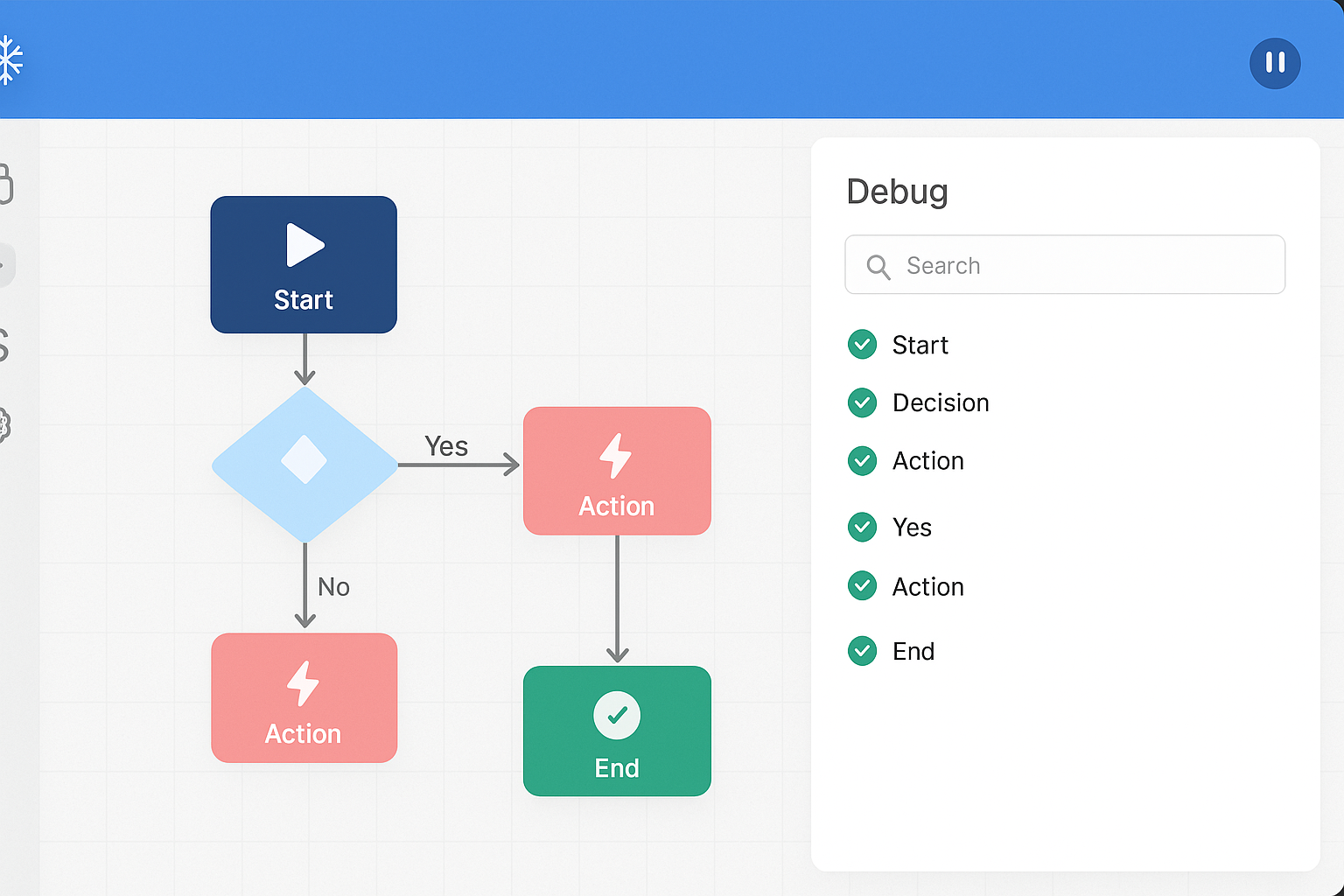Winter ’26 Flow Builder: What’s New in the Debug Panel

Introduction: Winter ’26 Flow Builder
In today’s hyper-competitive business landscape, efficiency isn’t just a goal—it’s a necessity. Organizations are relentlessly pursuing ways to eliminate manual tasks, reduce errors, and empower their teams to focus on high-value, strategic work. At the heart of this transformation lies automation, and for over 160,000 companies worldwide, Salesforce is the platform that makes it possible.
Salesforce pushes the boundaries of what’s achievable with declarative automation, and the Winter ’26 release is no exception. This update to Flow Builder is arguably one of the most significant, introducing a suite of features that democratize advanced automation, integrate AI seamlessly, and fundamentally change how admins and developers build solutions.
Table of Contents
The State of Automation: Market Trends Driving Salesforce’s Strategy
To understand the “why” behind the Winter ’26 features, we must look at the broader market forces shaping enterprise software.
1. The Citizen Developer Boom:
There’s a massive shortage of skilled developers. Gartner predicts that by 2025, 70% of new applications developed by organizations will use low-code or no-code technologies, up from less than 25% in 2020. Salesforce is leaning heavily into this trend, empowering “citizen developers” (aka admins and business analysts) to build complex applications.
2. AI and Automation Convergence:
Automation is no longer just about “if this, then that.” It’s about smart, contextual, and predictive actions. The integration of generative AI and predictive models directly into workflow tools is a top priority for every major SaaS provider.
3. Hyper-Personalization at Scale:
Customers and employees expect experiences tailored specifically to them. Static, one-size-fits-all processes are obsolete. Modern automation must be dynamic, data-driven, and capable of delivering unique experiences for millions of users simultaneously.
4. The Demand for Composable CRM:
Businesses don’t want monolithic, rigid systems. They want a composable CRM where they can assemble and reassemble capabilities like building blocks to adapt quickly to changing market needs. Flow is the primary tool for composing these custom experiences on the Salesforce Platform.
Key Features of Winter ’26 Flow Builder: A Game-Changer for Admins
The Winter ’26 release delivers a plethora of enhancements designed for power, simplicity, and intelligence. Let’s break down the most impactful ones.
1. Flow Triggers (Generally Available)
This is the headline feature. Flow triggers allow you to start an autolaunched flow based on a database operation (create, update, delete, undelete) without needing to use Process Builder or Apex triggers.
- How it Works: You can now define a flow to run “Before Save” or “After Save” on a record, just like an Apex trigger. “Before Save” flows can modify records in memory before they are committed to the database, enabling validation and field updates without saving twice.
- Why it Matters: The change consolidates automation tools, simplifying the architecture. It significantly reduces the need for Apex triggers for common tasks, putting more power directly into the hands of admins. It’s a crucial step toward the eventual retirement of Process Builder.
2. Embedded Flows in OmniStudio (Beta)
For enterprises using Salesforce Industries (Vlocity), this integration is monumental. You can now embed screen flows built in the standard Winter ’26 Flow Builder directly into OmniStudio FlexCards and OmniScripts.
- How it Works: Admins can create a complex screen flow for example, a data collection wizard and drop it as a component into an OmniScript step, creating a unified user experience.
- Why it Matters: It breaks down the silos between Salesforce Core and Industries, allowing for incredible flexibility and reusability of components. Companies can leverage the simplicity of Flow Builder for specific tasks within their larger, industry-specific OmniStudio processes.
3. New Flow Actions and Elements
- Loop Element Enhancements: You can now break out of a loop based on a condition before iterating through all items, a basic programming construct that was strangely missing and highly requested.
- Subflow Outputs to Data Sources: A subflow can now not only return variables but also create, update, or delete a record directly. This simplifies data manipulation within complex, multi-layered flow architectures.
- External Services Improvements: Making it easier to call external APIs (REST) remains a focus, with continued improvements to the External Services setup wizard, reducing the need for complex Apex code for integration.
4. Einstein for Flows
AI is woven directly into the fabric of Flow Builder.
- Einstein Next Best Action: This is enhanced to be more powerful within flows, allowing you to dynamically suggest the optimal next step a product, offer, support article, or action to a customer service agent or sales rep within an automated process.
- Predictive and Generative AI: While some features are still on the horizon, the foundation is being laid to inject predictive scores (e.g., probability to close) and generative content (e.g., auto-drafting a response email) directly into flow logic.
Real-World Use Cases: Solving Business Problems with Winter ’26 Flows
How do these features translate into tangible business value? Here are three scenarios:
Use Case 1: Streamlining High-Velocity Lead Qualification (Using Flow Triggers)
Problem: A marketing team runs a digital campaign generating thousands of leads. Many are low-quality or duplicates, wasting sales resources.
Winter ’26 Solution: Create a Before Save flow on the Lead object.
- Trigger: On Lead creation.
- Logic: The flow checks the lead’s website domain, company name, and email against existing leads and contacts using a fuzzy matching logic. If a strong match is found, it automatically converts the new lead into a contact under the existing account and triggers a different “new contact” process instead of a “new lead” process.
Benefit: Eliminates duplicate records before they are created, ensures data hygiene, and routes truly new leads to sales instantly.
Use Case 2: Dynamic Pricing and Approval Engine (Using Loop Break and Subflows)
Problem: A company needs a multi-tiered approval process for discounts on opportunities. The approval threshold changes based on the product family and deal size.
Winter ’26 Solution: Build a master flow triggered when an opportunity amount is updated.
- Logic: The flow loops through Opportunity Line Items. Using the new Loop Break functionality, it can exit early if any single line item has a discount over a hard-coded maximum, triggering an immediate VP approval.
- For the total discount, it calls a subflow that handles the approval logic, which can now directly update the Opportunity record with the approval status and create approval tasks.
Benefit: A highly dynamic, rules-based approval system built entirely declaratively, adaptable to complex and changing business rules.
Use Case 3: Unified Financial Services Onboarding (Using Embedded Flows in OmniStudio)
Problem: A bank uses OmniStudio for its customer onboarding but needs a specific, compliant process for collecting beneficiary information that its core banking team maintains separately.
Winter ’26 Solution: The OmniStudio team builds the main onboarding OmniScript. For the beneficiary collection step, they simply embed a screen flow built by a Salesforce core admin that handles all the nuanced data entry and validation.
Benefit: Best of both worlds. Specialized teams can work on their areas of expertise (industries vs. core), and the end customer gets a seamless, single-page application experience without context switching.
Step-by-Step Implementation Tips for Getting Started
Jumping into these new features requires a thoughtful approach.
1. Audit and Plan:
Before using Flow Triggers, inventory your existing Process Builder processes and Apex triggers. Identify which ones can be migrated. Start with simple “After Save” record-triggered flows before tackling complex “Before Save” logic.
2. Master the Trigger Context:
Understand the differences between Before Save (no record ID, can edit fields) and After Save (has record ID, can perform post-commit actions and async tasks). Remember, before save flows do not allow DML operations or callouts.
3. Start with a Pilot:
Choose a low-risk, high-value business process to pilot the new features. For example, migrate a simple Process Builder that updates a field on a record update to a record-triggered flow. Measure its performance and stability.
4. Embrace Reusability with Subflows:
As you build new flows, think modularly. If a piece of logic (e.g., sending a specific notification, calculating a score) could be used elsewhere, build it as a subflow with clear inputs and outputs. The new data manipulation outputs make this even more powerful.
5. Governance is Key:
With great power comes great responsibility. The ease of building complex automations can lead to recursion and performance issues. Implement a Center of Excellence (CoE) to establish naming conventions, documentation standards, and peer review processes for flows, especially record-triggered ones.
Expert Insights: Beyond the Clickable Tools
“While the new features in Winter ’26 Flow Builder are incredibly powerful, the biggest mistake I see organizations make is diving in without an architecture plan,” says [Fictional Industry Expert], a Salesforce MVP and CTO at Automation Partners.
“Flow Triggers are a paradigm shift. You must now think about the order of execution and trigger frameworks declaratively. How will your ‘Before Save’ flows interact? What if you have five flows on the same object? My advice is to treat flows like code: version them, test them in a sandbox, and remember that with the ability to create and update records in subflows, you can easily create infinite loops if you’re not careful. Always build with error handling and debug logs in mind.”
Key Takeaways:
The Winter ’26 Flow Builder is more than a simple update; it’s a definitive statement on the future of development on the Salesforce Platform. It blurs the lines between admin and developer, between core CRM and industry-specific solutions, and between automated and intelligent processes.
By embracing these features, organizations can build more resilient, adaptable, and efficient business processes. They can reduce their technical debt by replacing code with clicks, and most importantly, they can accelerate their digital transformation initiatives by empowering a wider range of talent to create solutions.

